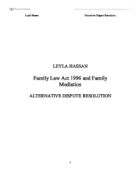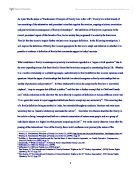- That any risk to one of the parties to the marriage, and to any children of violence from the other party should, so far as reasonably practical, be removed or diminished. These principles construct a framework, within which the court and all others who use the Act must operate.
Part II: Divorce:
Proceedings for decrees of divorce or judicial separation will be deal with in part II of 1996 Act and become divorce and separation orders respectfully. The divorce order dissolves the marriage, the separation order provides for the separation at the parties to the marriage (S. 2). The order comes into force on being made. The separation order remains in force (1) while the marriage continues, or (2) until cancelled on the joint application of both parties.
Part III
Ancillary relief after divorce, nullity, and judicial separation.
Consideration of arrangements for the children of the family
The Children Act 1989 brought significant procedural changes to the method by which the court considers and approves arrangements for the children on divorce. The Family Proceedings Rules 1991, r. 239 now place the main burden of ‘considering’ those arrangements upon the district judge, whereas under the old law the judge used to hear the ‘children’s appointments’. The new version of S. 41 Matrimonial Causes Act 1973 requires that in any proceedings for divorce, judicial separation, or nullity the court must consider, at the date on which the court considers the arrangements:
- Whether there is any child of the family who has not reached the age of 16, and;
- Whether there is a child who has reached 16 in respect of whom it should direct that S. 41 should apply.
In practice, the district judge in special procedure cases will usually carry out this duty where there is no application for an order under the Children Act 1989 pending in respect of a child of the family.
Mediation
So what is Mediation?
Family Mediation, which was introduced by the Family Law Act 1996, offers divorcing or separating couples a way to resolve difficulties when making new arrangements for children, home, finance, and possessions. Couples reach their own mutually acceptable agreements rather than negotiating through solicitors or courts.
How does mediation work?
Couples may be referred through a solicitor, other agencies, or self-referral. An initial meeting with a mediator is arranged to discuss suitability. This may be alone or with your partner. A series of meetings will then follow, each lasting one and a half hours, with an average of 3 to 6 meetings needed. At the end of the process the Mediator draws up a Memorandum of Understanding, this is not a legally binding document but can be used as the basis of a legal agreement. The mediation meetings are confidential unless it appears that a child or third party is at risk. The meetings are legally privileged; this means that whatever is said in mediation cannot be used elsewhere. If financial issues are included full, financial disclosure is required thus both parties have full knowledge and control over future arrangements. Mediation is not a substitute for legal advice and clients are encouraged to consult a solicitor throughout the mediation process.
PART II
The Petition…
Of Samantha Humphries shows that on the 23rd of June 1978 the Petitioner was lawfully married to the Respondent Simon Humphries at St. Georges Gospel Church in Peckham.
The Petitioner is a full-time housewife and resides at the Former Matrimonial Home at 34 Oak Tree Drive in Shirley, Hampshire.
The Respondent is a Managing Director of Goldman and Humphries Ltd. and resides at 67 Lincoln Road in Shirley, Hampshire.
There are three children of the family namely
Lucinda Humphries d.o.b 15th January 1980
Kate Humphries d.o.b. 30th September 1984
Gary Humphries d.o.b. 27th October 1988
No arrangements have been made for the provision of maintenance or periodical payments for the Petitioner or the children of the family.
The marriage has broken down irretrievably.
The Respondent has behaved in such a way that the Petitioner cannot reasonably be expected to live with the Respondent.
- Since the birth of the second child, the Petitioner had found a condom in the Respondent’s car. Petitioner was on the pill at the time and never used a condom with her husband. Six weeks later, the Petitioner found text messages on the respondent’s phone from a Jenna Jameson, who he had claimed was his secretary at his work. The text messages that were written were “thanks for last night, love J. xx” and “I miss you loads, when am I going to see you next?” luv J. xxx”.
- The Petitioner confronted the Respondent on 30th November 1984 and he confessed to the affair, apologising profusely and swearing to never to do it again. The petitioner forgives him after six months because of the children and that she loves him.
- After the birth of their third child, the petitioner fell ill to post-natal depression. However, the respondent had started working 12-18 hour days because of the decline in sales in the business. The petitioner thought that her husband was having another affair as she started smelling perfume on his shirts. In February 1999, the petitioner caught the respondent kissing a brown-haired woman in the car park. She confronted him and told him that the marriage was off and that he had lied to her.
- In March 2000, the respondent left the matrimonial home, as the petitioner would not allow him to live in that house anymore.
The petitioner claims:
Maintenance for herself and her children
Costs
Child support
Half of the marital assets.
Simon Humphries:
Managing Director earning £186,500 a year.
Currently lives with his secretary in a one room flat rent £300 per month, in Shirley, Southampton.
The Former Matrimonial Home is a 5-bedroom house worth £750,000. There is a mortgage of £279,750. The parties purchased the home in joint names in 1978 for £230,000, using £50,000 of the petitioner’s savings and the rest from the earnings that the husband made.
The husband continues to pay the mortgage and all the outgoings on the former matrimonial home.
The eldest child lives away from home, in student accommodation. The two younger children go to college and school 10 minutes away from home, by car.
Samantha Humphries last worked before Lucinda was born in 1980 as a legal secretary. She gave up work completely to look after the children. Simon has always provided for her; he was the one that committed adultery so he should provide for her and the two younger children now.
Husband feels very strongly about the Petition:
Since the decline in sales at his firm, he has had to put more hours in to provide for the home and because the wife gave up work, he has to earn all the family income. He feels that it is not too much to ask to have a wife, who comforts him and makes him a good meal when he comes home. He is aware that she looks after the children during the best part of the day but he is a very good father and will not give up the children because of the marriage breaking down.
He admits to the first adultery but not to the second, he claims that he was not in the car the time that the wife claimed that she saw him. He was in fact in his office, trying to catch up on some paperwork.
He agrees that the marriage has broken down and wants a divorce, as he cannot put up with wife’s moodiness anymore.
Will Family Mediation benefit Simon and Samantha Humphries?
Family mediation is less formal, quicker, and cheaper than going to court and it is family focused – the welfare of the children comes first. It is able to address misunderstandings thus reducing conflict and stress. It is a forward-looking process. It is a voluntary process.
You get the help of a neutral third party. It has confidence in the fact that it can help retain relationships.
Bibliography
- The Family Law Act 1996, M.L. Follette, R. Purdie, Butterworths
- A practical approach to Family Law, Sixth Edition, J. Black, J. Bridge, T. Bond, Blackstone
- Community and neighbour mediation, M. Liebmann, Cavendish Publishing







